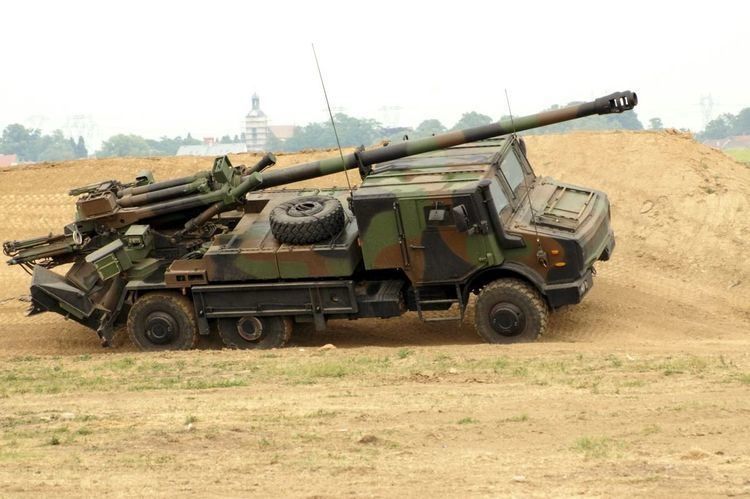Place of origin France Weight 17.7 tonnes | Designer GIAT Length 10 m (32 ft 10 in) | |
 | ||
Type Self-propelled howitzer Wars War in Afghanistan, Cambodian–Thai border stand-off, Operation Serval, Battle of Mosul | ||
The CAESAR (CAmion Equipé d'un Système d'ARtillerie; French: Truck equipped with an artillery system) is a French self-propelled 155 mm/52-calibre gun-howitzer, installed on a 6X6 truck chassis. Examples built for the French Army use a Renault Sherpa 10 chassis, examples built for export utilize the 6x6 Unimog U2450L chassis. The CAESAR platform was developed by the former GIAT Industries (now known as Nexter) and is operated by the French, Indonesian, Saudi Arabian, and Thai militaries.
Contents
Development
Caesar was developed in the 1990s as a technology demonstrator by the French state-owned company GIAT Industries; in cooperation with Lohr Industrie. It was first shown in public in 1994. Four years later a pre-production model underwent trials with the French Army.
The Caesar artillery system evolved from the earlier 155 AM F3 automotive gun, which used the chassis of the AMX-13 light tank.
Design
The CAESAR is a wheeled, 155mm 52-caliber self-propelled howitzer. It holds 18 rounds and is typically operated by a crew of five, though if necessary, the CAESAR can be operated by as few as three men. It can be transported by C-130 or A400M, and has a firing range of approximately 42 km using an Extended Range, Full Bore (ERFB) shell, and more than 50 km using rocket assisted shells. The system is integrated with a fully computerized system, providing an automatic control. During Eurosatory 2006, CAESAR was exhibited with an automated laying system based on the SIGMA 30 inertial navigation system.
Nexter is developing an armored cab for the CAESAR in response to demand for more protection for the crew. The additional armor will protect against IEDs and roadside bombs, anti-vehicle mines, and 155 mm shells landing as close as five meters (16 feet) away from the vehicle. It can be added to the cabs of existing CAESARs. Heavier armor will increase its weight by 400 kg (880 pounds) and raise the price by 4-5 percent.
Caesar 8x8
In 16 September 2015, Nexter has unveiled the Caesar 8x8 at DSEI 2015 with high level of mobility ensured by a modified TATRA 8x8 chassis. The 8x8 Caesar being shown is fitted with a standard unarmoured forward control four-person cab, but one of the options is a fully armour protected cab. Gross vehicle weight would depend on the level of armour protection, but is about 30 tonnes. It is powered by a 410 hp diesel engine.
Current operators
Potential operators
Operational deployment
In June 2009, the French Chairman of the Joint Chiefs of Staff confirmed that eight CAESAR would be sent to Afghanistan to support French operations. They were deployed during the summer.
Three were deployed 1 August 2009 by the 3rd Marine Artillery Regiment (3è RAMa), followed by five others, deployed as a firebase in FOB Tora, Tagab and Nijrab. They are fitted with cabin armor add-ons, with fireport.
The French army deployed this system in southern Lebanon as part as the UNIFIL peace keeping force.
During Operation Serval in Mali 4 CAESAR were deployed by the 68e régiment d'artillerie d'Afrique (68th Artillery of Africa Regiment).
In April 2011, the Royal Thai Army used the CAESAR against Cambodia's BM-21, Thai Army claimed that they destroyed more than 2 BM-21 systems.
Four CAESAR were deployed to Iraq for the Battle of Mosul, where French forces are supporting the Iraqi army and an international coalition forces to reclaim Mosul from ISIL in October 2016.
